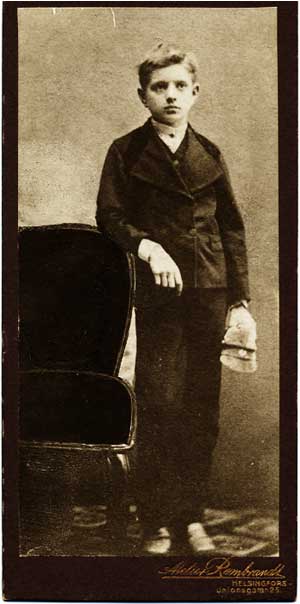Jean Sibelius
Jean Sibelius (8 December 1865 – 20 September 1957) was a Finnish composer and violinist of the late Romantic and early-modern periods. He is widely recognized as his country's greatest composer and, through his music, is often credited with having helped Finland develop a national identity during its struggle for independence from Russia.
Early Life[edit | edit source]
Jean Sibelius was born Johan Julius Christian Sibelius in Hämeenlinna in the Grand Duchy of Finland, then part of the Russian Empire. His interest in music was evident from an early age, and he began violin lessons at the age of five. Despite his passion for the instrument, Sibelius later decided to focus on composition. He studied music in Helsinki, Berlin, and Vienna, where he was influenced by the Romantic tradition, particularly the works of Richard Wagner and Anton Bruckner.
Career[edit | edit source]
Sibelius's career spanned over six decades, during which he composed a wide range of music, including symphonies, chamber music, piano music, violin concertos, and choral music. However, he is best known for his seven symphonies and his tone poems, such as Finlandia, Valse Triste, The Swan of Tuonela, and Tapiola. His music is characterized by its emotional depth and use of the Finnish landscape as inspiration.
His most famous work, Finlandia, was composed in 1899 as a protest against increasing censorship from the Russian Empire. It quickly became a symbol of Finnish nationalism and independence.
Despite his success, Sibelius struggled with self-doubt and periods of creative silence, particularly later in his life. After his Seventh Symphony, completed in 1924, he produced very little new major works and none of his symphonic stature, leading to speculation about an "eighth symphony" that was never completed or destroyed.
Personal Life[edit | edit source]
Sibelius was married to Aino Järnefelt, with whom he had six daughters. His home, named Ainola after his wife, located near Lake Tuusula in Järvenpää, Finland, became a center of culture and music in Finland. Sibelius lived there for the rest of his life, passing away in 1957 at the age of 91.
Legacy[edit | edit source]
Jean Sibelius's legacy is profound, both in Finland and internationally. His music played a significant role in the formation of the Finnish national identity and continues to be celebrated for its beauty, complexity, and emotional depth. Sibelius's birthday, December 8, is celebrated in Finland as the Day of Finnish Music. In 2015, to mark the 150th anniversary of his birth, numerous concerts and events were held worldwide to celebrate his life and works.
Search WikiMD
Ad.Tired of being Overweight? Try W8MD's physician weight loss program.
Semaglutide (Ozempic / Wegovy and Tirzepatide (Mounjaro / Zepbound) available.
Advertise on WikiMD
|
WikiMD's Wellness Encyclopedia |
| Let Food Be Thy Medicine Medicine Thy Food - Hippocrates |
Translate this page: - East Asian
中文,
日本,
한국어,
South Asian
हिन्दी,
தமிழ்,
తెలుగు,
Urdu,
ಕನ್ನಡ,
Southeast Asian
Indonesian,
Vietnamese,
Thai,
မြန်မာဘာသာ,
বাংলা
European
español,
Deutsch,
français,
Greek,
português do Brasil,
polski,
română,
русский,
Nederlands,
norsk,
svenska,
suomi,
Italian
Middle Eastern & African
عربى,
Turkish,
Persian,
Hebrew,
Afrikaans,
isiZulu,
Kiswahili,
Other
Bulgarian,
Hungarian,
Czech,
Swedish,
മലയാളം,
मराठी,
ਪੰਜਾਬੀ,
ગુજરાતી,
Portuguese,
Ukrainian
Medical Disclaimer: WikiMD is not a substitute for professional medical advice. The information on WikiMD is provided as an information resource only, may be incorrect, outdated or misleading, and is not to be used or relied on for any diagnostic or treatment purposes. Please consult your health care provider before making any healthcare decisions or for guidance about a specific medical condition. WikiMD expressly disclaims responsibility, and shall have no liability, for any damages, loss, injury, or liability whatsoever suffered as a result of your reliance on the information contained in this site. By visiting this site you agree to the foregoing terms and conditions, which may from time to time be changed or supplemented by WikiMD. If you do not agree to the foregoing terms and conditions, you should not enter or use this site. See full disclaimer.
Credits:Most images are courtesy of Wikimedia commons, and templates, categories Wikipedia, licensed under CC BY SA or similar.
Contributors: Prab R. Tumpati, MD






